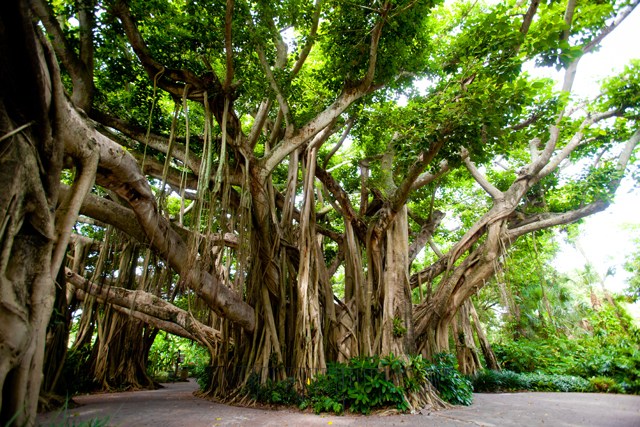
Article Detail
26 Nov
India is losing its green cover and we know that we are lagging behind in making up for it. But it’s good to know about the vegetation that grows in our country. We are talking about trees. You’ll be surprised to know that India is home to a large variety of trees. It was not possible to compile all of them so we picked 9 common trees that we see around and don’t know much about. ……
1. Banyan Tree

Scientific name– Ficus benghalensis
Banyan tree is the most familiar tree in our country. Interestingly, it originated in India itself. These trees have the largest canopy coverage in India. Not many people know but the banyan tree is also the national tree of India.
How to recognise it?
The leaves look like those of a fig tree. If you pluck a leaf, a white sticky liquid is visible.
2. Neem tree

grow-trees
Scientific name– Azadirachta indica
It is grown in both tropical and sub-tropical regions. Neem has endless medicinal properties and that’s what makes it popular in India. It is used to control pests and deal with pox viruses. Neem is a major ingredient in soaps and shampoos and is healthy for our skin.
How to recognise it?
It is slightly difficult to spot the real neem tree because the chinaberry tree looks quite similar to it. It has a strong smell and its flowers are pale white in colour, and grow from March to May. Its leaves grow in pairs along a long common stem.
3. Peepal tree

Scientific name–Ficus Religiosa
The peepal tree falls in the category of dry season deciduous or semi- evergreen tree. This is one of those rare trees that release oxygen both in the day and the night.
How to recognise it?
The leaves of this tree are heart-shaped with an extended drip tip.
4. Arjuna tree

Scientific name– Terminalia arjuna
Arjuna tree is generally found around river beds. It is not difficult to spot one. Arjuna exhibits yellow flowers from March to June. It has a woody fibrous fruit that appears between September and November.
How to recognise it?
The woody fruit has five wings and is possibly the most unique looking fruit. If you see it, you can guess the tree’s name easily.
5. Sal Tree

Scientific name– Shorea Robusta
Sal is a large deciduous tree. The tree is native to the Indian sub-continent. The sal tree is hardly leafless. It is said that the tree provides good quality timber. Interestingly, the sal tree is worshipped by Hindus and Buddhists.
How to recognise it?
The leaves of the sal tree are ovate-oblong in shape. Their texture is rough and they have a peculiar shine on their upper surface.
6. Gulmohar tree

Scientific name– Delonix Regia
Gulmohar is most famous for its pretty looking flowers. In India, its flowering season is between April and June. Spotting this tree is quite easy as it grows in dry as well as tropical conditions. The tree spreads and provides a dense shade. The flowers of this tree are large and orange-red in colour.
How to recognise it?
Its leaves are doubly pinnate. Each leaf is approximately 40 cm long and has 20-40 pairs of primary leaflets that are feathery in appearance and bright, light green in colour.
7. Indian Mahogany

Scientific name– Swietenia mahagoni
In India, these trees are mainly found in Thattekkad Wildlife Sanctuary, Kaziranga Wildlife Sanctuary and Corbett National Park. The trunk of this tree is used to make furniture and musical instruments.
How to recognise it?
The tree is generally 30-40 feet in height. Its fruit resembles a large greenish capsule and its wood is red brown in colour.
8. Curry tree

Scientific name– Murraya koenigii
Curry tree is a tropical to sub-tropical tree and is native to India and Sri Lanka. Its leaves are widely used in south Indian dishes because of their strong aroma.
How to recognise it?
It is a small tree growing up to 6 metres. Its leaves are pinnate and have 11-21 leaflets. The plant produces small white flowers that self pollinate and produce small black berries.
9. Ashoka Tree

Scientific name– Saraca asoca
Ashoka tree is a rain-forest tree and is abundantly found in the central areas of the Deccan plateau and in parts of the Western Ghats. This tree is an evergreen one and is known for its foliage and fragrant flowers. Its leaves are dark green in colour and grow in bunches.
How to recognise it?
Its leaves grow in dense clusters and are pointed from the top. The flowering season is February to April. The flowers grow in heavy bunches as well. They are bright yellow and orange in color.
Here at Harith Tharang, we have saplings for trees which can be earthed in your place. Get all the manures, tools and garden accessories for your garden at Harith Tharang. Call us @ 9841937297 | 044 65275990 located @ 42, Bazullah Rd, T.Nagar, Chennai


